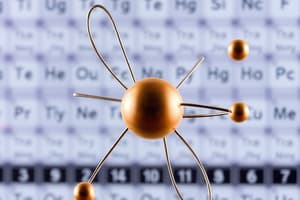Podcast
Questions and Answers
What is the defining factor that determines the identity of a chemical element?
What is the defining factor that determines the identity of a chemical element?
- Number of neutrons
- Number of protons (correct)
- Number of electron shells
- Number of electrons
Which group in the periodic table contains elements with properties similar to sodium and potassium?
Which group in the periodic table contains elements with properties similar to sodium and potassium?
- Group 18 (Noble gases)
- Group 2 (Alkaline earth metals)
- Group 14 (Metalloids)
- Group 1 (Alkali metals) (correct)
As you move from left to right across a period in the periodic table, which trend increases?
As you move from left to right across a period in the periodic table, which trend increases?
- Metallic character
- Atomic size
- Ionization energy (correct)
- Electronegativity
What part of an atom is responsible for the majority of its mass?
What part of an atom is responsible for the majority of its mass?
In terms of electron configuration, what do elements in the same group in the periodic table have in common?
In terms of electron configuration, what do elements in the same group in the periodic table have in common?
Which property describes an atom's ability to attract electrons towards itself in a chemical bond?
Which property describes an atom's ability to attract electrons towards itself in a chemical bond?
What is the general electronic configuration for s-block elements?
What is the general electronic configuration for s-block elements?
How do d-block elements arrange their electrons?
How do d-block elements arrange their electrons?
What determines the valency of an element?
What determines the valency of an element?
How do nonmetals generally compare to metals in terms of valency?
How do nonmetals generally compare to metals in terms of valency?
What is the relationship between group number and valence electrons?
What is the relationship between group number and valence electrons?
Why is the periodic table considered a valuable tool for understanding chemical properties?
Why is the periodic table considered a valuable tool for understanding chemical properties?
Flashcards are hidden until you start studying
Study Notes
Atoms and Periodic Table
Atomic Structure
The smallest unit of a chemical element is an atom. Atoms are composed of three types of particles: protons, neutrons, and electrons. Protons and neutrons are found in the nucleus at the center of the atom, while electrons orbit around the nucleus in energy levels called electron shells. The number of protons in an atom's nucleus is known as the atomic number and determines the chemical element's identity.
Classification of Elements
The periodic table is a tabular arrangement of the chemical elements, organized by their atomic number, electron configuration, and recurring chemical properties. It consists of 18 vertical columns called groups (1-18) and 7 horizontal rows called periods. Each group is named based on its electron configuration and general properties, such as alkali metals (Group 1), alkaline earth metals (Group 2), metalloids (Group 14), nonmetals (Group 15, 16, and 17), and noble gases (Group 18).
Periodic Trends
As elements move from left to right in the periodic table, their properties change systematically. This is attributed to the changing electron configurations and the increasing number of electrons in the outermost energy level. These trends include increasing atomic size, ionization energy, electronegativity, and metallic character.
Electron Configuration
The arrangement of electrons in an atom's energy levels is described by its electron configuration. Electrons are arranged in shells with increasing energy levels and subshells with a specific set of electron pairs. The general electronic configurations for elements in the periodic table are:
- s-block elements (Groups 1 and 2): ns 1-2
- p-block elements (Groups 13-18): ns.2p 1-6
- d-block elements (Groups 3-12): (n-1)d 1-10 ns 1-2
- f-block elements (Lanthanides and Actinides): (n-2)f 1-14 (n-1)d 0-1 ns 2
Chemical Bonding and Valency
Chemical bonding occurs when atoms share or transfer electrons to achieve a stable electron configuration. The valency of an element refers to its chemical reactivity and the number of bonds it can form. Metals typically have low valencies, while nonmetals have higher valencies. The number of valence electrons for a group of elements is the same as the group number, and the group number is determined by the last digit of the group number.
In summary, the periodic table is a valuable tool for understanding the properties and relationships among the chemical elements. It provides a framework for understanding the trends and patterns in element properties, which is crucial for understanding chemical reactions and the behavior of matter.
Studying That Suits You
Use AI to generate personalized quizzes and flashcards to suit your learning preferences.




